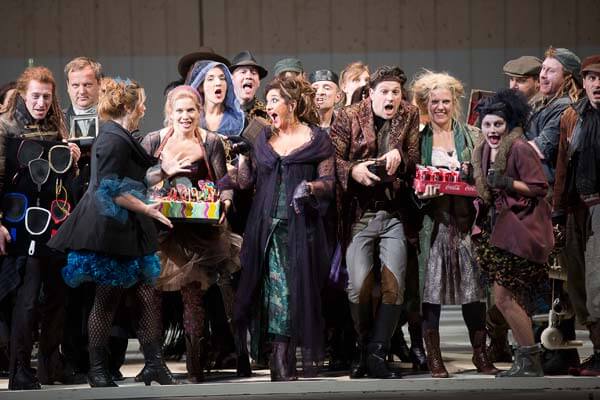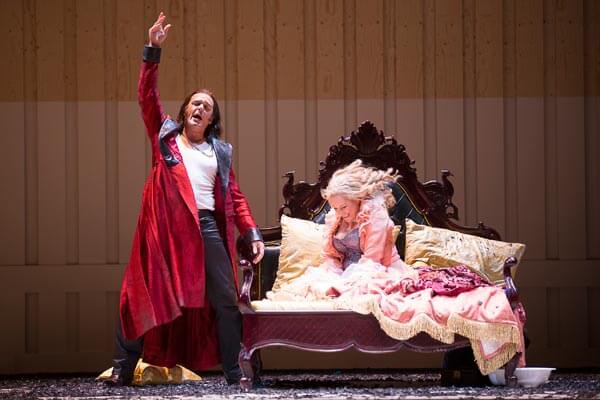 In 1731, the British artist William Hogarth made a series of six paintings titled “A Harlot’s Progress.” They depicted the tragic life of the naive young Moll Hackabout, a country girl who moves to London to find her fortune but quickly finds herself a penniless prostitute. The engravings copied from these paintings sold so well that, a year later, Hogarth created another storyboard set of paintings, “The Rake’s Progress.” The narrative here is similar, with young Tom Rakewell also being tempted into moral decay by the vagaries of easy cash and the big city. Stravinsky wrote an opera based on the second set of paintings, with a libretto by W.H Auden and Chester Kallman; an excellent production of this opera went up at Theater an der Wien in September. The same company produced the world premiere of A Harlot’s Progress October 13-27 in Vienna, with a libretto by Peter Ackroyd and music by Iain Bell.
In 1731, the British artist William Hogarth made a series of six paintings titled “A Harlot’s Progress.” They depicted the tragic life of the naive young Moll Hackabout, a country girl who moves to London to find her fortune but quickly finds herself a penniless prostitute. The engravings copied from these paintings sold so well that, a year later, Hogarth created another storyboard set of paintings, “The Rake’s Progress.” The narrative here is similar, with young Tom Rakewell also being tempted into moral decay by the vagaries of easy cash and the big city. Stravinsky wrote an opera based on the second set of paintings, with a libretto by W.H Auden and Chester Kallman; an excellent production of this opera went up at Theater an der Wien in September. The same company produced the world premiere of A Harlot’s Progress October 13-27 in Vienna, with a libretto by Peter Ackroyd and music by Iain Bell.

Theater and der Wien’s production of The Harlot’s Progress (photo credit: © Werner Kmetitsch)
As the plot of The Harlot’s Progress paintings is very similar to The Rake’s Progress, so the downfall of the protagonist in Bell’s opera mirrors that of Stravinsky’s. But this new opera asks: what would have happened, were Tom Rakewell a woman? The answer is (in order of appearance): sex, violence, sexual violence, pregnancy, syphilis, madness, and an agonizing death. The main difference between the Auden/Kallman/Stravinsky depiction of such a wretched descent and the Ackroyd/Bell treatment is subtlety. Whereas The Rake’s Progress is an opera full of beautiful, delicate, and tragic moments as the protagonist falls victim to the devil within and without, The Harlot’s Progress bluntly tells the audience how horrible it was to be poor in London in the 18th Century. Observing the sins of Tom Rakewell portrayed on stage allows the observer to draw several possible conclusions, and leaves room for thoughts about poverty and contemporary society. Watching Moll Hackabout be repeatedly raped on stage, as she suffered the madness of syphilis for the sin of wanting to be rich, did not evoke any inquiry about the nature of poverty as experienced specifically by women; it was purely sexist, degrading and unnecessary. The company provided no trigger warning for sexual violence either in its advertising material or house program; several people left the theatre hastily during the first act.
The score for this opera also lacked subtlety. There were some lovely musical moments: Moll’s first scene of illicit lovemaking with James was briefly tender, providing a bit of character development for Moll; and Bell’s incorporation, in several places throughout the opera, of British folk songs was deft and clever. On the balance, however, the score lacked discipline. Many interesting ideas were layered over each other and topped with a thick slathering of percussion, underneath which the voices were left to fend for themselves. Vocal lines were far too frequently doubled, especially by the violins and high winds, and an almost-constant growl from the low range of the orchestra muddied the orchestration substantially. From the middle of the overture until the curtain fell, everything was either loud or louder. Growth in characters or changes in emotional mood were not often hinted at by the music, muddying the intent of the libretto. This lack of clarity and focus in execution of the score weighed down some genuinely promising musical gestures. Given time and air, they could be developed into something touching and forceful.

Theater and der Wien’s production of The Harlot’s Progress (photo credit: © Werner Kmetitsch)
When they could be heard, the vocal performances in this opera provided a bright point. Diana Damrau as Moll Hackabout chewed up the curtains with some force, which musical assertiveness made her character’s brittle choices even less believable. Tara Erraught was an even more elemental vocal force as the sidekick Kitty, while Nathan Gunn was deeply delicious as the rakish James Dalton.
The costuming and props made an attempt at Steampunk, without managing the edgy eccentricity of that aesthetic. Combined with the boring, minimalist set, the visual effect was less 18th century London-made-universal than jumble-sale mashup. Director Jens Daniel Herzog added a few interesting ideas, including a chilling opening scene with the chorus writhing in the foggy, murky streets. But on the whole, there was little creativity in his staging; he relied too heavily on the lazy depiction of sexual violence to convey grittiness.
An opera based on a morality tale should further a social discussion. It is not enough anymore to merely regurgitate a tale exactly as a man three centuries ago thought it useful, especially when it was a man preaching about how women should live their lives. If we are to be shown someone’s wretched downfall, let there be a reason for this depiction: why is it useful for us to see this character’s terrible life? Good art can give us insight into the nature and causes of human suffering. Bad art simply goes through the motions of discomfort without asking why. In a story as oft-repeated in opera as this one, the bar is set very high. Unfortunately, all elements of this opera lacked the necessary depth to add anything to this conversation.




















